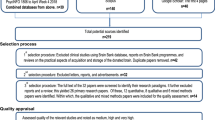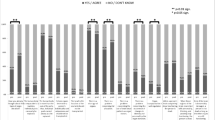Abstract
Understanding what influences people to donate, or not donate, body organs and tissues is very important for the future of transplant surgery and medical research (Garrick in J Clin Neurosci 13:524–528, 2006). A previous web-based motivation survey coordinated by the New South Wales Tissue Resource Centre found that most people who participated in brain donation were young, female, educated Australians, not affiliated with any particular religion, and with a higher prevalence of medical illness than the general Australian population. It discussed the main motivating factors for brain donation to be “the benefits of the research to medicine and science”. This study has been replicated in a paper-based version to capture a broader cross-section of the general population, to find out who they are and what motivates them to donate. All consented and registered brain donors (n = 1,323) were sent a questionnaire via the post and recipients were given 3 months to complete the questionnaire and return it in a reply paid envelope. Results were entered into the original web-based survey and analyzed using SPSS version 10. Six hundred and fifty-eight questionnaires were returned completed, a response rate of 53%. The results show that people from all age groups are interested in brain donation. The over 65’s are the largest of the groups (30.7%). The majority of the participants were female (60.6%), married (49.2%) with children (65.8%), employed (52.9%) and have a tertiary education (73.3%). They were either non-religious (48.2%) or Christian (41.6%) and were mostly Australian (65.4%). Most (81%) had pledged to donate other organs and tissues for transplantation. The most commonly cited reasons for the donation were to benefit science (27.6%), to benefit medicine (23.9%), a family illness (17.5%) and to benefit the community (16.6%). This study demonstrates that people across all age groups are interested in brain donation. Recruitment of new brain donors could target the over 65 female Australians, who are not religious or Christian and who have also donated other organs and tissues for transplant purposes. It also indicates the need to make donation for research part of the national transplant donation program.
Similar content being viewed by others
References
Arnold R, Bartlett S, Bernat J et al (2001) Financial incentives for cadaver organ donation: an ethical reappraisal. Ethics Committee of the American Society of Transplant Surgeons. Available via OVID/MEDLINE. Accessed 2 Feb 2006
Azizi L, Garrick TM, Harper CG (2006) Brain donation for research: strong support in Australia. J Clin Neurosci 13:449–452. doi:10.1016/j.jocn.2005.06.008
Bennett R, Savani S (2004) Factors influencing the willingness to donate body parts for transplantation. J Health Soc Policy 18(3). Available via OVID/MEDLINE. Accessed 12 Feb 2006
Boyes M, Ward P (2003) Brain donation for schizophrenia research: gift, consent, and meaning. J Med Ethics 29. Available via URL: www.jmedethics.com. Accessed 12 Feb 2006
Garrick T, Howell S, Terwee P et al (2006) Brain donation for research—who donates and why? J Clin Neurosci 13:524–528. doi:10.1016/j.jocn.2005.06.014
Lawlor M, Dobbins T, Thomas K et al (2006) Consent for corneal donation: the effect of age of the deceased, registered intent, and which family member is asked about donation. Br J Ophthalmol doi:10.1136/bjo.2006.098921. Available via URL: bjo.bmjjournals.com. Accessed 12 Oct 2006
Lovern E (2001) HHS launches bid for organ donations. Mod Healthc Apr 23:21
Midgley M (2000) Biotechnology and monstrosity: why we should pay attention to the “yuk factor”. Hastings Cent Rep 30(5). Available via OVID/CINAHL. Accessed 12 Feb 2006
Pearson I, Chapman J (1999) Improving organ donor rates. Med J Aust 170:463–464
Sade R (1999) Cadaveric organ donation: rethinking donor motivation. Am Med Assoc 159(5). Available via OVID/MEDLINE. Accessed 12 Feb 2006
Schmitt F, Wetherby M, Wekstein D et al (2001) Brain donation in normal aging: procedures, motivations, and donor characteristics from the biologically resilient adults in neurological studies (BRAiNS) projects. Gerontologist 41(6). Available via OVID/MEDLINE. Accessed 15 Feb 2006
Stevens M (1998) Factors influencing decisions about donation of the brain for research purposes. Age Ageing 27(5). Available via OVID/MEDLINE. Accessed 15 Feb 2006
Author information
Authors and Affiliations
Corresponding author
Rights and permissions
About this article
Cite this article
Glaw, X.M., Garrick, T.M., Terwee, P.J. et al. Brain donation: who and why?. Cell Tissue Bank 10, 241–246 (2009). https://doi.org/10.1007/s10561-009-9121-8
Received:
Accepted:
Published:
Issue Date:
DOI: https://doi.org/10.1007/s10561-009-9121-8




